Merle causes irregular patches of diluted pigment in all eumelanin-pigmented areas. Merle creates random patterns but different allelic combinations can result in some distinct phenotypes.
What is Merle?
Merle impairs the ability of pigment organelles to function properly. This causes a random mixture of areas with lighter diluted patches and areas with normal pigment production.
Merle creates a visually interesting pattern in which some eumelanin areas of the coat turn paler or white. Merle only removes pigment and never adds anything new.

A typical merle expression gives a marbled look to the coat with irregularly diluted and intensely pigmented patches.
But merle can create some different patterns depending on the combination of merle alleles.

Merle affects all eumelanic regions and dilutes random sections of any black, liver, blue or lilac areas in a dog’s pattern. But merle very, very rarely affects areas with phaeomelanin which will stay solid-colored on most dogs with both pigment types.
But: Merle can and does affect red pigment if the allele itself (Mh/m) or a combination of alleles is “strong enough” to delete pigment. So given the right merle alleles it is possible for a merle a pattern to be visible “through” phaeomelanin!

If merle takes enough pigment away faint tan markings that would’ve normally been masked can become visible.

Dogs with merle often have pink spots on their noses, different eye colors or sectoral heterochromia.
And higher doses of merle tend to delete ever more pigment to white. This can cause health implications seen in double merle phenotypes like auditory and visual impairment.

Want to learn more? I highly recommend you check out Mary Langevin’s book “Merle – SINE insertion from Mc-Mh” with lots of information about all the different aspects of merle patterns in dogs.
The Merle Locus
Merle is caused by a SINE insertion (Short Interspersed Nuclear Element), a piece of foreign DNA that inserted itself in the PMEL gene (premelanosome protein) on dog chromosome 10 (also known as SILV gene). SINE are believed to have parasitic origins that can basically copy and paste themselves into different genomic locations.
But these short pieces of “viral DNA” are very, very common and even compose a big chunk of the mammalian genome! SINE can have deleterious effects but also provide a great source of genetic variability. Not only merle alleles, very many variants on different loci only differ only by the absence or presence of a SINE[4].
The PMEL gene at the Merle Locus plays a vital role in the maturation of melanosomes. The SINE sequence seems to produce an unstable situation that creates random sections with normal or impaired PMEL function.
The Merle SINE consists of a head, a body and finally a poly-A tail of a variable length containing a long string of repeating base pairs. And different SINE lengths each seem to have a different ability to interfere with normal pigment production.

Merle Alleles
For many years, merle tests only detected the SINE body and reported every dog with a SINE as Merle (M/-). But new research provided evidence that the length of the poly-A-tail actually creates different merle expressions.
So new tests not only check for the presence of a SINE but for the actual SINE insertion length and report the number of base pairs (bp). And this new high-resolution testing method has led to a larger portfolio of Merle alleles that differ in their length of the poly-A-tail: Mh, M, Ma+, Ma, Mc+, Mc and m.
| Merle Allele | SINE length |
|---|---|
| Mh | 269+ bp |
| M | 265-268 bp |
| Ma+ | 255-264 bp |
| Ma | 247-254 bp |
| Mc+ | 231-246 bp |
| Mc | 200-230 bp |
| m | – |
Merle is an incomplete dominant trait that causes an intermediate expression of both alleles a dog has on its M-Locus. Some of these allelic combinations are known to cause some distinct patterns.
With 7 different merle alleles, there are 28 possible combinations like Mh/Mc or Ma+/m. The phenotypic expression of a merle pattern is somewhat dosage-dependent.
The more “merle” a dog accumulates from both alleles the more pigment is deleted. Lesser alleles like Mc, Mc+ or Ma have a weaker effect than Ma+ or M while Mh can delete pigment to white all by itself. But it takes a bit of practice to predict how combinations like Ma+/Ma+ or M/Ma might look.
Some combinations of merle alleles are considered quite harmless while “too much merle” can cause severe impairments and a double merle phenotype. So every breeder of a dog breed with merle should learn everything they can about merle to avoid at-risk breeding.
Merle Calculator
This simple tool can help you predict the patterns and potential risk of different M Locus combinations.
Thanks to Mary Langevin and Corinne Benavides for providing information about at-risk combinations. But of course, no one can provide any guarantee that puppies from a specific mating will be free of genetic health conditions.
Mosaicism
One interesting aspect of merle is the occasional shortening of base pairs of major merle alleles like M to shorter versions like Ma+.
This causes a mosaic genotype where some cells contain the original merle allele (e.g. M/m) and some contain the shortened merle allele (e.g. Ma+/m) while each individual cell still only has two alleles (M/m or Ma+/m).
During growth, the embryonic cells differentiate into specialized cell types. The phenotypic pattern of a dog with a mosaic genotype depends on when the shortening happened and where in the body the genotypically different cells end up.

Mosaic genotypes are often reported as something like M[Mc+]/m (indicating that Mc+ is the minor allele in this example). But it’s hard to predict the phenotypic impact of a mosaic genotype since this highly depends on what cells of the body got which allele!
And merle shortening not only happens in somatic cells, but it can also happen in reproductive cells. Gonadal mosaicism can cause a shortening of base pairs between parents and offspring.
Different biological materials in mosaic animals tend to have different allelic compositions[2]. But what a dog can pass on to its offspring only depends on the alleles present in its sperm or egg cells.
Merle Patterns
Let’s talk about the variety of different patterns merle can create:
Hidden Merle
Any coat coloration that can mask a merle pattern can cause hidden merle or masked merle.
Since merle in almost all cases only affects eumelanin it very rarely causes a pattern in dogs without eumelanin in their coat. This includes dogs with only phaeomelanin in their coats like recessive red or clear sable as well as solid white dogs with extreme spotting.

Yes, some dogs with hidden merle have blue eyes or heterochromia. But some other genes can also cause blue eyes, so that brown eyes are not a reliable indicator for non-merle anyway!
Dogs with hidden merle can’t express the pattern but they are capable of producing merle offspring. This creates a risky situation when a dog that just “doesn’t look merle” is bred to a merle dog.
The term “hidden merle” is not used for dogs that have a very minimal merle expression of merle (minimal merle) or dogs that have a shortened non-expressing merle allele (cryptic merle).
Cryptic Merle Mc, Mc+
Cryptic merle describes dogs with a SINE insertion that got so short that it doesn’t cause merle expression.

The cryptic merle alleles Mc or Mc+ cause no deletion of pigment by themselves. So a dog with Mc/m or Mc+/m will not express any merle. Especially the weaker Mc basically breeds as non-merle.
Even dogs with Mc/Mc or Mc+/Mc+ don’t express any merle pattern at all.
Atyical Merle Ma, Ma+
The atypical merle alleles Ma or Ma+ got their names because they can cause an almost uniformly diluted phenotype (maltese merle) in the absence of color dilution. It can also express with a lighter undercoat or a beige to brownish hue (muddy merle).


Ma/m should not produce a merle pattern but can cause a pale or brownish hue in the coat. Ma+/m can cause a faint or muted pattern with small spots of full pigmentation on a pale greyish or brownish base.



Mc+/Ma+ or Ma+/Ma+ sometimes cause a tweed pattern with diluted spots in different shades of grey or brown.
Both Ma/m and Ma+/m sometimes don’t affect the coat at all. This can create situations where two non-expressing parents (Ma+/m ) surprisingly produce offspring with a merle pattern (Ma+/Ma+)!
Classic Merle M
Classic merle M is the desired phenotype according to many breed standards. It creates a random marbled pattern by contrasting dark and diluted patches.

The M allele gives a strong enough effect to cause blue eyes by itself but is considered safe in M/m or M/Mc combinations.
M/Mc+ can sometimes give a tweed pattern with patches of different colors and M/Ma can cause a patchwork merle pattern with large patches of solid color, solid diluted color, white or patches with minimal dark spotting.

In combinations higher than M/Ma+more and more pigment is deleted to white. M/M and M/Mh create typical double merle phenotypes with a high percentage of white over the body.
Harlequin Merle Mh
The harlequin merle allele Mh is the longest merle allele, it can cause pigment deletion to white all by itself.
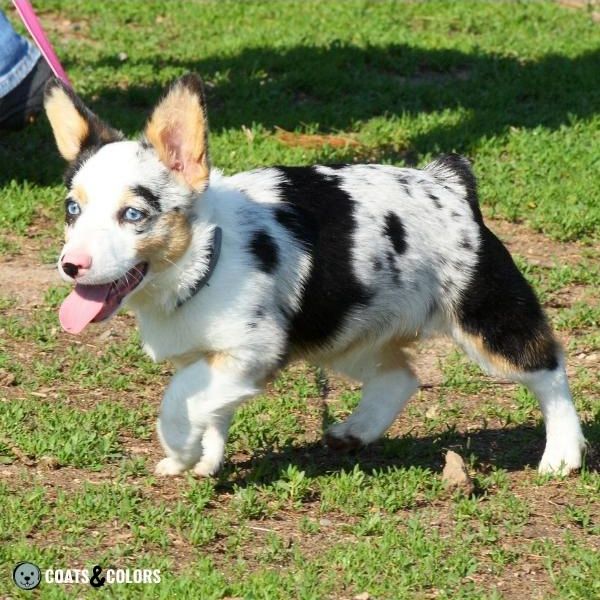
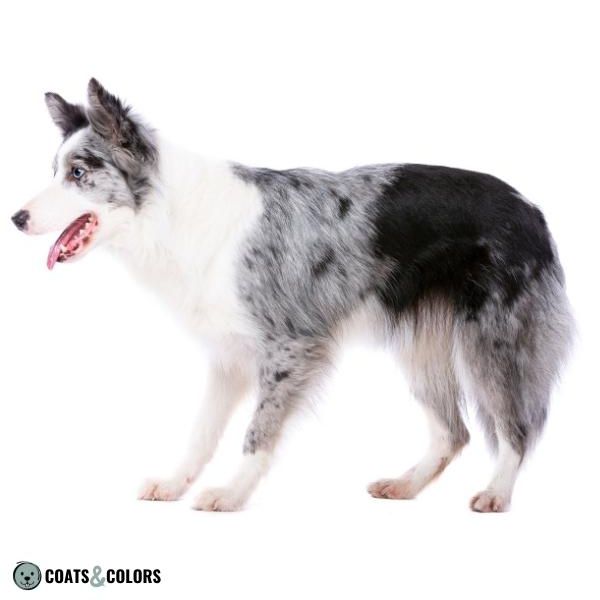

What makes it stand out is the tendency for its all-or-nothing behavior. Mh often creates phenotypes with big non-merle , white or dilute patches of varying color (tweed merle or herding harlequin).


M/Mh and Mh/Mh can delete much of a dog’s pigment to white and pose a great risk to cause a double merle situation.
Harlequin merle (Mh) is not the same as harlequin in Great Danes!
Minimal Merle
If merle is restricted to very small areas on a dog’s body this is called minimal merle. Some dogs express merle only on their face, chest and legs creating a merle trim.


In many cases, dogs with a minimal pattern are harlequin merle (Mh/-) with one big non-merle spot covering most of the dog.
Another explanation is mosaicism when the original longer allele became the minor allele and the non-expressing shorter allele became the major allele (eg. Mc+/[M]/m.

Tweed Merle
Tweed or patchwork phenotypes can be caused by some different allelic combinations like M/Mc+, Mh/m or most commonly M/Ma.
This term is used to describe a dog with a combination of big and less ragged patches that are almost solid black, brown, grey, white or yellowish. Dilute spots in different shades are very common.



Merle Combinations
Merle only affects eumelanin, so it has a different impact on certain patterns.
Merle Colors
Eumelanin can be black, brown, blue or lilac. On a dog with a solid coat color all of the coat will be merle.
Black merle often is called blue merle because of the greyish color the diluted areas most often have. A truly diluted black aka blue dog with merle sometimes is called slate merle.
Brown merle is also called liver merle, chocolate merle or red merle although these dogs are not really red (as in dogs with a high phaeomelanin intensity).


Eye and Nose Color
Merle creates its typical pattern by reducing some of the eumelanin pigment in the coat. But it also can delete pigment from the eye or skin.
This can create pink spots on the nose (sometimes called butterfly nose). And it can cause solid blue eyes or cause heterochromia (different eye colors) or sectoral heterochromia (different color sections in the same eye).
But: Blue eyes are not a good way to tell if a dog is merle! Dogs without merle can have blue eyes and dogs with merle can have solid brown eyes.

Merle and Coat Types
Most breeds with merle are either short-coated or long-coated.
On very shaggy, curly or wirehaired dogs the merle pattern can be tousled beyond recognition. This can almost create a hidden merle situation where the pattern is not recognizable in the phenotype.
This should be considered before adding merle to a breeding program.

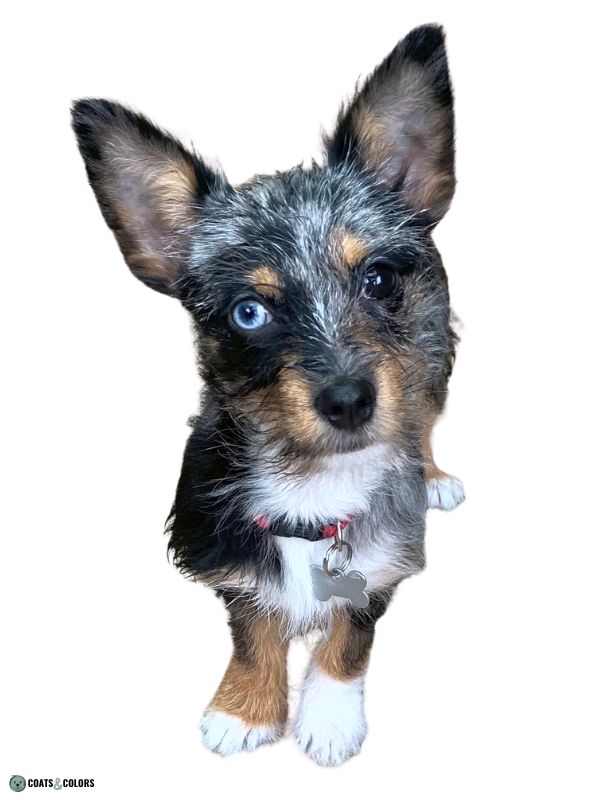
Tanpoint Merle
On a tan point pattern, only black areas express a merle pattern while the tan markings are not affected.





Saddle Merle
On a dog with creeping tan or a saddle pattern merle will only be visible in the dark sections of the coat. So if the only area with eumelanin is a dark saddle on a dog’s back then a merle pattern can only be expressed in the saddle.
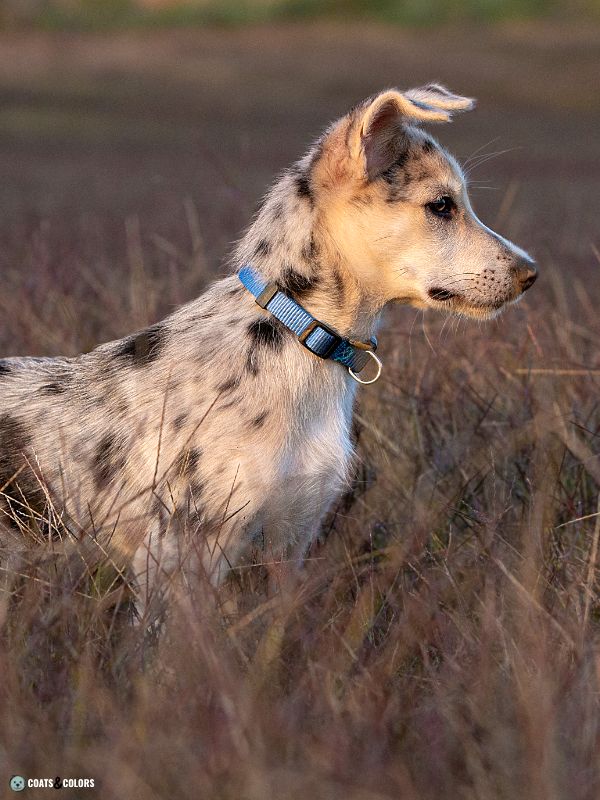

Sable Merle
Sable can have varying amounts of dark shading in the form of dark hair tips or minimal hair banding.

Since only these darker hair tips get their color from eumelanin merle will only be visible in areas with enough shading to produce a visible pattern.
Clear sable often comes without any dark shading which can hide merle. Sometimes merle is only visible in puppy coat and clears when the puppy shading disappears.
Only Mh and very “strong” combinations of alleles can in some rarer cases have an effect on red coat.


Brindle Merle
Brindle produces dark stripes on any tan-colored area. Merle dilutes some sections of the striping pattern which often is barely noticeable at first glance.
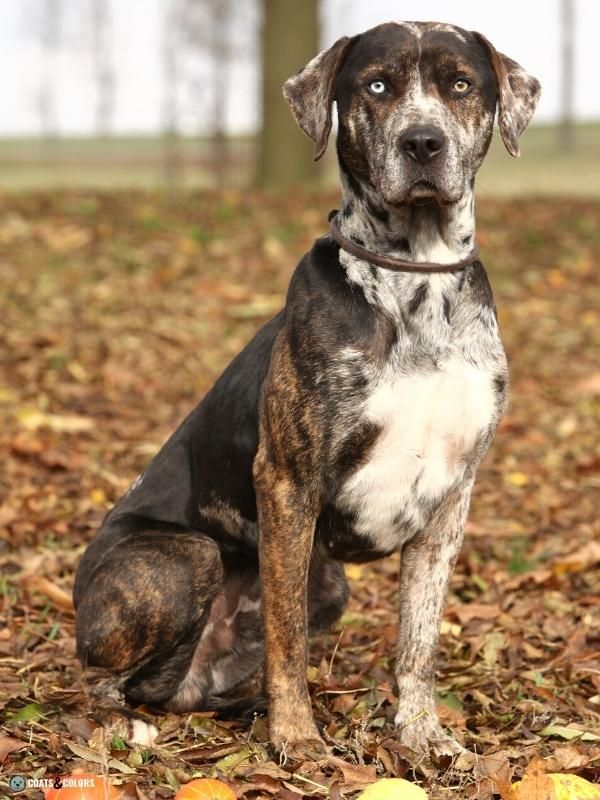


Agouti Merle
Dogs with an agouti pattern usually have lots of banded hairs on their back and enough eumelanin to express merle. Agouti merle often creates a somewhat blotty and hard-to-spot phenotype but this is a rather rare combination anyway.

Merle Masks
Melanistic masks on a dog’s muzzle can lose some pigment due to merle. This usually makes the underlying pattern (e.g. sable or tan point) visible and leaves some non-merled patches.
Remember, merle doesn’t add dark patches, it only takes away some pigment. So if a dog has some random black dots on tan these might be the remnants of a dark mask.


Merle Ticking
Dogs with merle and white spotting can develop ticking that can also be merled. Some dogs with merle and ticking can be found in Border Collies or piebald Dachshunds.

Seal Merle
Seal makes dominant black coat a little transparent and lets an underlying sable pattern shine through.
Seal can give a very brownish shade even on a genetically black dog. And in a seal merle pattern, all of the still fully colored patches of the merle pattern will have a brownish shade.
Domino Merle
This is a rare combination since domino patterns are most often found in northern breeds or sighthounds and not in any of the traditional merle breeds. Domino removes eumelanin from any given pattern and gives a lighter undercoat. So it makes the areas where merle can “do its thing” smaller.
Some dogs with a combination like this can be found in Pomsky dogs or other dogs with a Husky background. Here is an example of a mixed breed dog that could be a tan point domino merle (probably Mh/m ky/ky at/at eA/e).
Harlequin Modifier
Great Danes can express a harlequin pattern (not to be confused with harlequin merle Mh).
Harlequin is a merle modifier and a dog needs to be both merle and harlequin to express this pattern. Great Dane harlequin turns all diluted areas in a merle pattern to white. What remains is a pattern with solid black patches on a white base.
Health Issues and Double Merle
What happens if a dog happens to have “too much merle”?
Harlequin merle (Mh/-) or combinations of longer merle alleles like M/Ma+ or M/M can delete so much pigment that they not only create white markings on a dog’s body but can also cause a double merle situation.
This video shows the progression of white caused by higher doses of merle:
Dogs with “too much merle” in general are not only prone to have too much white coat. They are also predisposed to be born with ophthalmologic and auditory impairments.
This is commonly referred to as a double merle effect which is often noticeable due to the high amount of white, blue eyes and pink noses it causes in a dog’s pattern.

Although many more problems like skeletal issues or a reduced life expectancy are anecdotally assigned to double merle there is no evidence that double merle causes more than auditory and ophthalmologic abnormalities.
Technically, every dog that has two merle alleles is a homozygous merle. But it’s important to distinguish between homozygous merle as a genetic term and double merle as a descriptive term traditionally used for M/M.
Not every dog tested as “M/M” truly is “double merle”. That’s because some companies that can’t test the different lengths of Merle will simply report any homozygous genotype like M/Mc, Mh/Ma or Ma/Mc as “M/M“.
But: Not every combination of merle alleles deletes pigment to white or has adverse health implications. But some merle combinations are indeed known to more often lead to problems than others.
It’s generally best to at least avoid any of the combinations that are known to cause issues too regularly:
| High Risk | Mh/Mh, Mh/M, Mh/Ma+, Mh/Ma, M/Ma+, M/M |
| Medium Risk | Ma+/Ma+, Mh/Mc+ |
| Low Risk | Mh/m, Mh/Mc, M/Ma, M/Mc+, Ma+/Ma, Ma+/Mc+ |
Man dog owners are not fully aware of the many allelic combinations and complexity of merle genetics. But breeders should learn to use the information available to avoid any at-risk breedings.
Genetic testing for merle prior to breeding is a useful tool that can help determine what kind of merle a dog has, what it can produce and it can also detect masked merle in recessive red or high white phenotypes.

Dog Breeds with Merle
There are very many dog breeds where merle is bred as one of the regular standard colors. Merle is present in many herding breeds but was also introduced in a variety of other types of dogs.
Due to a preference for some patterns over others, some breeds might be enriched for specific merle alleles due to selection for the phenotypes they cause. In many breeds, only a classic pattern (M) is desired while patterns produced by other alleles (e.g. Mh, Ma) are sometimes even considered as mismarks.
According to the standards of the major kennel clubs, merle is not an accepted color for every breed that nowadays comes in merle (like poodles, pomeranians, spaniels or bully breeds). Oftentimes merle was introduced into breeds and designer dogs rather recently by crossbreeding.
These are the dog breeds where merle is common:
- Alapaha Blue Blood Bulldog
- Australian Shepherd Dog
- Beauceron
- Bergamasco Shepherd
- Border Collie
- Carea Leonés
- Catahoula Leopard Dog
- Dachshund
- Great Dane
- Koolie
- Louisiana Catahoula Leopard Dog
- Miniature American Shepherd
- Mudi
- Norwegian Dunker
- Old German Herding Dogs
- Prague Ratter
- Pyrenean Shepherd
- Rough Collie
- Shetland Sheepdog
- Smooth Collie
- Welsh Sheepdog
- Welsh Corgi Cardigan
Merle Look-Alikes
Black merle turns black areas to grey which is often called “blue merle” although these dogs are not really blue. But a diluted grey coat from maltese merle phenotypes can indeed look a little like color dilution or progressive greying.
And heavy ticking or roan are often confused with the torn black patches on a grey base from merle.
Some people think every dog with blue eyes might be merle. That is not correct since any type of pigment deletion like white spotting can cause blue eyes. And some breeds like Australian Shepherds or Siberian Huskies even have their own mutation that causes blue eye color independent from the coat coloration.
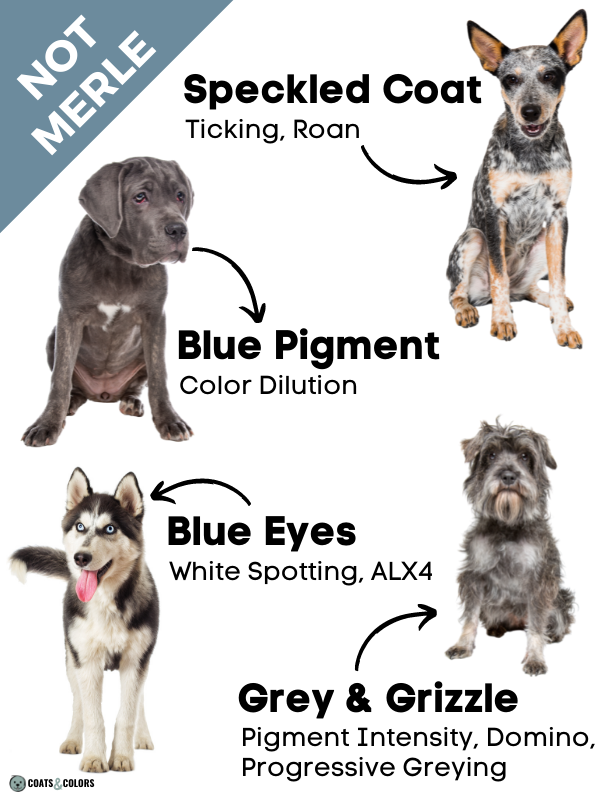
Learn More
Links
[1] Clark LA, Wahl JM, Rees CA, Murphy KE (2006) Retrotransposon insertion in SILV is responsible for merle patterning of the domestic dog. Proceedings of the National Academy of Sciences of the United States of America 103: 1376–1381. pmid:1640713. https://doi.org/10.1073/pnas.0506940103
[2] Langevin M, Synkova H, Jancuskova T, Pekova S (2018) Merle phenotypes in dogs – SILV SINE insertions from Mc to Mh. PLoS ONE 13(9): e0198536. https://doi.org/10.1371/journal.pone.0198536
[3] Strain, GM., Clark, LA., Wahl, JM., Turner, AE., Murphy, KE. Prevalence of deafness in dogs heterozygous or homozygous for the merle allele. J Vet Intern Med 23:282-6, 2009. Pubmed reference: 19192156. https://doi.org/10.1111/j.1939-1676.2008.0257.x
[4] Wang, W., & Kirkness, E. F. (2005). Short interspersed elements (SINEs) are a major source of canine genomic diversity. Genome research, 15(12), 1798–1808. https://doi.org/10.1101/gr.3765505

Hi! I’m Steffi. I am a biologist and a big time dog nerd. You are curious about coat color genetics? You’ve come to the right place! Read more.

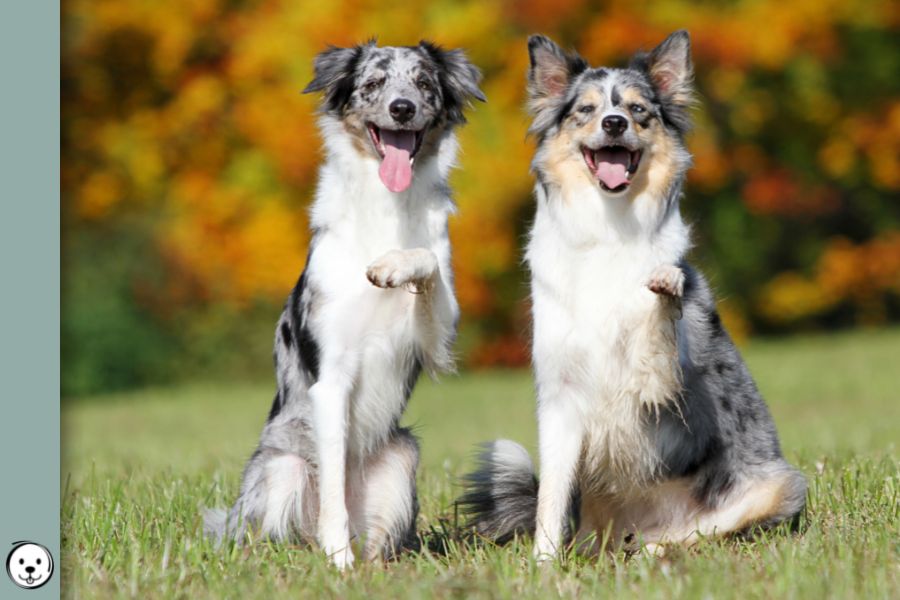






2 thoughts on “Merle-Locus”
Comments are closed.